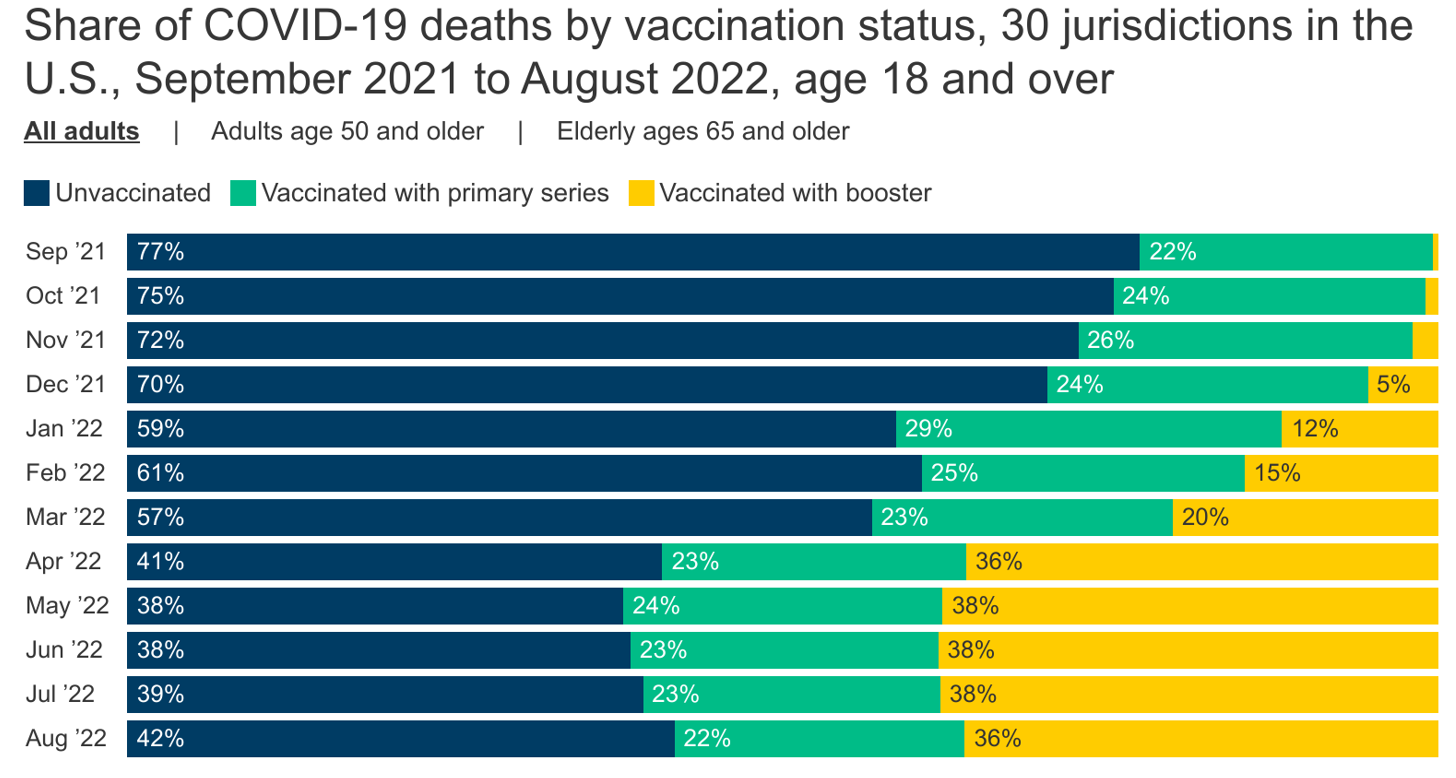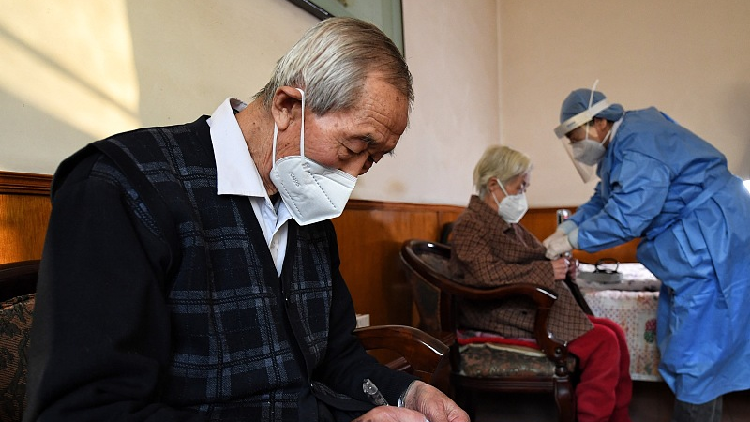Why Do Vaccinated People Represent Most COVID-19 Deaths Right Now?
Why Do Vaccinated People Represent Most COVID-19 Deaths Right Now? Kaiser Family FoundationView Full Coverage on Google News

The share of COVID-19 deaths among those who are vaccinated has risen. In fall 2021, about 3 in 10 adults dying of COVID-19 were vaccinated or boosted. But by January 2022, as we showed in an analysis posted on the Peterson-KFF Health System Tracker, about 4 in 10 deaths were vaccinated or boosted. By April 2022, the United States Centers for Disease Control and Prevention (CDC) data show that about 6 in 10 adults dying of COVID-19 were vaccinated or boosted, and that’s remained true through at least August 2022 (the most recent month of data).
The data from this chart come from the CDC, which collects data on the number of deaths by vaccination status from 30 health departments (including states and cities) across the country. In order to be counted as vaccinated, a person must be at least two weeks out from completing their primary series before testing positive (for example, at least 14 days after completing two doses of the mRNA vaccine). Similarly, to be counted as having a booster, a person must be at least two weeks out from their booster or additional dose before testing positive. People who were partially vaccinated are not included in this data.
In all jurisdictions, local health authorities review data to determine whether the death was associated with COVID-19 (through a review of vital records, cause of death, and/or other public health investigations or data sources), though methods vary by state or jurisdiction. Even with these reviews, it may sometimes be hard to determine the primary cause of death for someone with significant underlying health conditions, though these data are intended to be limited to cases where COVID-19 was a significant contributor to the death. From other data, we know there continue to be more overall deaths than there were before the pandemic (excess deaths). We focus our analysis here on adults. Fewer than 0.5% of COVID-19 deaths across all ages in 2022 have been among people under 25.
What explains the rising share of COVID-19 deaths among vaccinated people?
There are several factors at play here, including a rising share of the population that is vaccinated, waning immune protection and low uptake of boosters, and changes in immunity among the unvaccinated. New variants combined with a reduction in masking and other non-pharmaceutical interventions may also lead to more transmission, which can in turn lead to more deaths.
During the early rollout of vaccines, vaccinated people represented a small share of total deaths, but experts warned that the share would likely rise simply because vaccinated people were representing a growing share of the population. In other words, if 100% of people in the U.S. were vaccinated, vaccinated people would represent 100% of COVID-19 deaths. Similarly, as the share of the population with a booster rose somewhat during 2022, the share of deaths among boosted people also rose. COVID-19 vaccines are very effective at preventing severe illness and death, but they are not perfect, so deaths among vaccinated people will still occur.
Indeed, vaccinated people now make up the majority of the population – 79% of adults have completed at least the primary series – and the latest CDC data show that vaccinated people also now represent the majority of COVID-19 deaths. There are many more vaccinated people than there are unvaccinated people, and vaccinated and boosted people are, on average, older and more likely to have underlying health conditions that put them at risk for severe COVID-19 outcomes. That’s why, when CDC adjusts for some of these factors (age and population size), we still see that unvaccinated people are at much greater risk of death and other severe outcomes than people the same age who have stayed up-to-date on boosters. Older people are at greater risk for severe illness and death from COVID-19 than younger people, but vaccines and boosters still lower that risk substantially.
However, the rising share of the population that is vaccinated is only part of the story and does not seem to explain all of the rise in the share of deaths that are among vaccinated people over the last year. That’s because vaccination rates have grown only slightly during that period, yet the share of people dying who were vaccinated has risen more steeply (as shown in the chart above). COVID-19 is on track to be the third leading cause of death in 2022, for the third year in a row, and this year, about half of those deaths over the course of the year were among people who had at least their primary series.
CDC and other researchers have shown that protection from COVID-19 vaccines can diminish, or wane, over time and booster doses are needed to maintain a robust immune response. Although the data we use in this analysis are not broken out by time since last vaccination, given the plateauing vaccination rate, it is likely that many of the vaccinated people who died of COVID-19 had the primary series or a booster many months or even over a year earlier, meaning they were less protected against severe illness than they once were.
The waning protection from vaccines is why CDC recommends recent booster shots, and why it’s especially important for people at higher risk to stay up-to-date on boosters. Per current recommendations, most adults should have received at least 2-3 booster doses by now (including the new bivalent booster), in addition to their primary series. However, only 14% of adults overall and 31% of older adults (65 years and older) have received the latest bivalent boosters. The CDC data show that about 95% of adults who died from COVID-19 in 2022 in these jurisdictions were over age 50, and about 8 in 10 were age 65 or older, underscoring the need for older adults to stay up-to-date on recommended booster shots.
The fall in the share of deaths that are among unvaccinated people could also be explained by changes in the unvaccinated population. By this far into the pandemic, it is estimated that many unvaccinated people have had COVID-19 at least once and while hundreds of thousands of unvaccinated people have needlessly died from COVID, those who survived may have gained some immune protection against the virus that can help protect them against severe outcomes when they have subsequent infections. However, this protection from a past infection can also diminish over time, which is why it is still recommended that unvaccinated people with prior COVID-19 infections get vaccinated and stay up-to-date on boosters.
More transmission can also lead to more deaths. With the Omicron variant, combined with a reduction in other preventive measures like masking, vaccinated people may be more likely to be infected than they were this time last year.
Conclusion
It would be a misrepresentation of the finding to say it is evidence against vaccination. This finding actually underscores the importance of staying up-to-date on boosters.
According to CDC, people ages 12 and older who have had a bivalent booster shot have a 15 times lower risk of death than an unvaccinated person.
CDC and other researchers have shown boosters are highly effective in preventing hospitalizations and deaths, including among those most vulnerable to COVID-19. CDC now recommends the updated bivalent booster shot for everyone ages 5 year and above.



